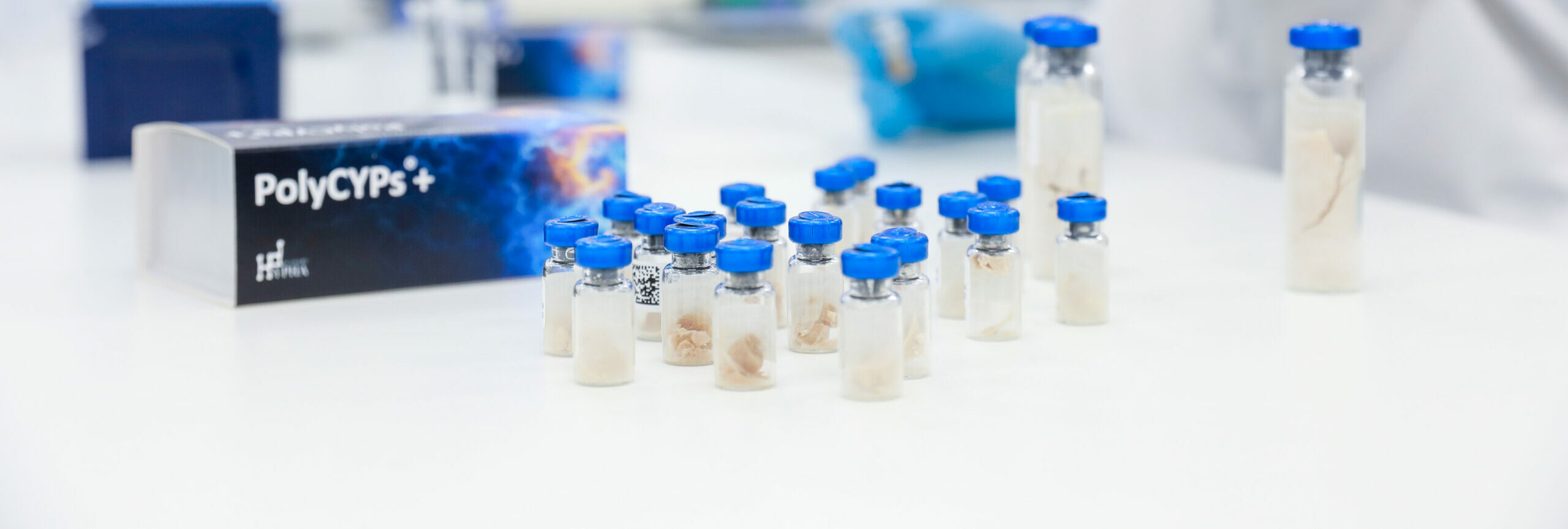Our Products
PolyCYPs+ kit instructions
PolyCYPs+ Kit Instructions
PolyCYPs kits are very easy to use. Detailed instructions and tips on how to use the kits are provided below. Please contact us at support@hyphadiscovery.com if you have any questions or need any advice.
Extract processing
We have put together a suggested procedure for processing PolyCYPs scale-up reactions, along with some handy tips.
PolyCYPs+ incubation conditions
Incubation conditions are important when conducting PolyCYPs reactions to ensure the best % conversions. Examples of suitable incubation conditions are given on page 3 of the instructions. We use a standard 150rpm on a shaker with a 5cm orbit for our PolyCYPs incubations. Other shaker types may have a different orbit which will impact oxygen transfer. Use this handy calculator for determining the best rpm to use for your shaker. You will need to know the orbit of your shaker in cm in order to use the calculator. The calculator works for most types of shakers but please contact us for more advice if your shaker has a very low orbit.
Examples:
The MaxQ Mini 4000 benchtop orbital shaker has a throw of 1.9cm. To achieve the same oxygen transfer of an orbital shaker with a throw of 5cm at 150rpm, a speed of 243 rpm is required.
The Eppendorf ThermoMixer has an orbit of 3mm. We recommend a maximum of 400 rpm if you are using this shaker type in order to prevent splashing during the incubations.
The Heidolph Titramax / Inkubator 1000 is a vibrating shaker and has an orbit of 1.5mm. Nevertheless we recommend a shaking speed of 400rpm.
Recommendations and tips
CYPs need oxygen so never restrict gas exchange – always incubate the reactions with the gas-permeable seals provided. However, CYPs are deactivated by bubbles so do not over agitate the reactions – stick to the instructions provided with the kit.
Use the 24-well square well blocks provided. Round well blocks and Eppendorf tubes have poor aeration resulting in poor conversion. Alternative suggestions are given on page 3 of the instructions but please ask for advice if you are unsure.
Resources
Explore our library of resources comprising brochures, case studies, posters and publications about the work we do.
Introducing oxygen into a drug candidate late in the optimisation process has several applications including exploration of SAR (structure-activity relationships) and the ability to access derivatives that may possess superior properties such as improved metabolic stability and LLE (ligand-lipophilicity efficiency). Biocatalysis can provide access to chemical space in a complementary manner to chemical synthesis and provide a “one-experiment” solution to accessing multiple derivatives in parallel. This poster illustrates the application of a new biocatalysis kit, PolyCYPs®, to enable parallel synthesis of hydroxylated derivatives of drugs.
In this case study at least 2 mg of a monohydroxylated metabolite (M4), originally observed in rat liver microsomes, was required by a US pharma company. Using PolyCYPs, the target metabolite was supplied to the client together with a Certificate of Analysis within 22 days from receipt of order, exemplifying the short timelines achievable using PolyCYPs to access CYP-derived metabolites.
Hypha’s PolyCYPs kits are in routine use by pharma and agchem companies for producing human and other mammalian metabolites. One application involves use of PolyCYPs for creating radiolabelled metabolites for direct comparison with the radio profiles from mass balance and distribution study samples, necessary for regulatory filing. PolyCYPs provides a clean route for scalable access to more of the CYP-derived metabolites observed in these matrices, for definitive MetID and any tox studies deemed necessary. This is especially useful where low concentrations or unstable metabolites in the mass balance sample make structural identification difficult.
Ready to begin? Our scientists are available to talk through your requirements
Hypha Discovery is a UK-based CRO supporting pharmaceutical and agrochemical companies worldwide through the production of metabolites and new derivatives of drugs and agrochemicals in discovery and development.
Resources
Cookie Policy | Privacy Policy | Website Terms and Conditions
© Hypha Discovery 2021. All Rights Reserved. Website by Fifteen.co.uk


